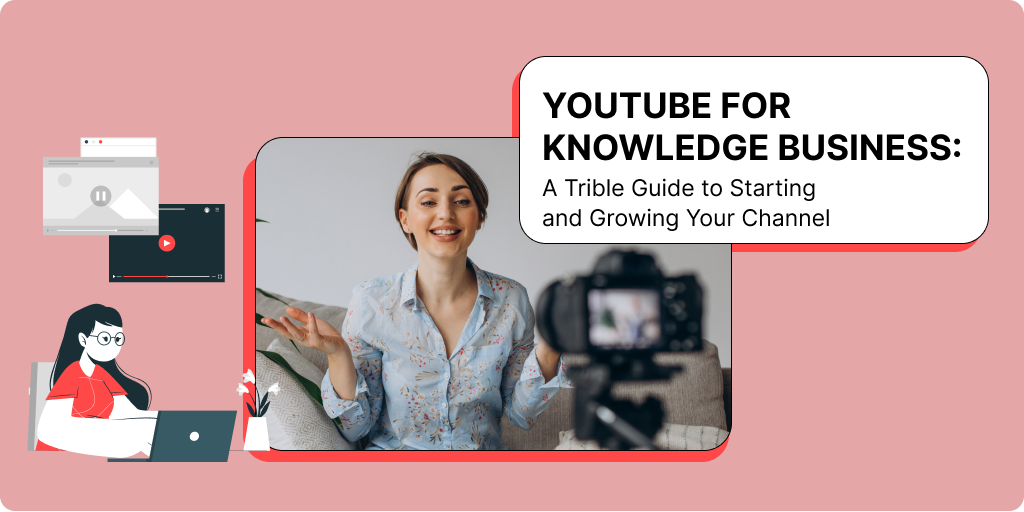For freelancers and entrepreneurs, creating a personal brand has never been more significant than it is today. Each of us with access to the web and social media can attract an audience, show themselves as an expert, and start engaging clients for their business. And that’s exactly what a lot of businesses are doing right now. According to an Upwork report, the freelance workforce is increasing three times faster than the entire employment in the United States. Freelancers are about to make up the most of the US workforce by 2027.
While it’s encouraging to see so many individuals embracing their entrepreneurial mindset, it also means that each and every self-employed freelancer, independent contractor, and business will soon face even more competition. Creating a unique personal brand is the key to distinguishing oneself from competitors.
Why should a business build a personal brand?

When you’re establishing a business around your specialization (as a writer, presenter, coach, advisor, freelancer, etc.), you’re definitely used to the notion of personal branding. Building your personal brand is ideal when you’re the face of your company.
Your brand is exactly what sets you apart from the competition, helping to create a lasting impression in the imagination of your audience and clients. You may struggle to develop a lucrative and sustainable business if you do not have a compelling personal brand that engages your target audience.
However, even if you’re starting a business with its own brands, such as a software or physical product enterprise, developing a personal brand offers a lot of advantages. The majority of individuals are more attracted to follow other people than particular companies. As a result, developing an audience for your personal brand might help your firm gain recognition.
Elon Musk, for instance, has more Twitter followers than all three of his businesses all together which are Tesla, SpaceX, and SolarCity. The same can be said for Richard Branson from Virgin, Arianna Huffington from Thrive Global, Gary Vaynerchuck from VaynerMedia, and numerous other effective business owners. They all have strong personal brands which they use to gain more publicity and clients for their businesses.
You do not have to choose between developing a personal brand and developing a corporate brand. You may construct both at the same time. Kevin Stimpson says that ‘Having a personal brand is vital for a business since it is more important than ever for CEOs and creators of companies/brands to stand out and interact with their clients. People connect with one another.’
Advantages of creating a personal brand
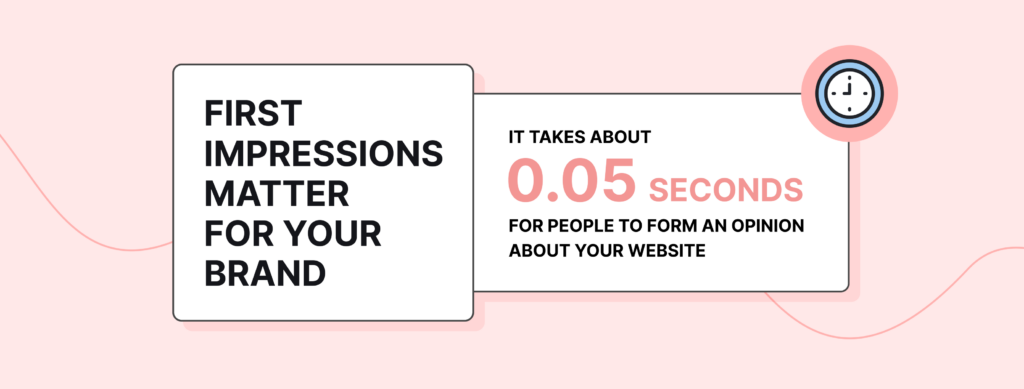
- Authority and trust. A personal brand will help you establish trust with your followers and establish yourself as an expert and also as a leader in your field.
- Obtain media coverage. Having a personal brand makes it simpler to pitch and be discovered by various media such as online publishers, magazines, tv channels, radio stations, podcast creators, and so on. The media is always looking for specialists who can share their knowledge with the public.
- Create a network. It is simpler for other people and entrepreneurs to perceive value in interacting with you if you have a personal brand that clearly states who you are, what you do, and how exactly you assist others. You may use your personal brand to swiftly and efficiently expand your network, both online and offline.
- Increase your client base. Creating a personal brand that establishes you as the go-to expert in a certain sector or specialty might help you attract more of your target clients. It is also easy to refer clients to you when you are positioned as an expert.
- Pricing at a premium. A strong personal brand might help you justify charging higher costs for your products and services. You get to be a commodity that competes on price if you don’t have a brand. And there will always be others willing to undercut your pricing.
- Make a long-lasting platform. Your company will develop over time. Over the course of your career, you may potentially launch many enterprises in different areas. Your personal brand follows you from one business to the next.
Pia Silva claims, ‘With so much content among a lot of new small businesses on the web, a brand that relates to a person’s face seems to be much better to trust. A personal brand requires less time and energy to build trust than a corporate brand.’
7 steps to building an attractive and profitable personal brand
Following consultations with dozens of business and branding experts, we’ve defined seven precise strategies to assist you in developing a compelling (and successful!) personal brand that attracts your ideal clientele. We have prepared a fillable Personal Branding Workbook that you can utilize as you go through these stages to help establish your personal brand strategy.
1. Build a foundation
The very first step in developing your personal brand is to construct a solid foundation upon which you can confidently and genuinely grow. The important principle, in this case, is authenticity. There is a common assumption that developing a personal brand entails creating a character. However, a persona is, by definition, a façade. It is an inauthentic representation of who you are because it is not a real reflection of who you are.
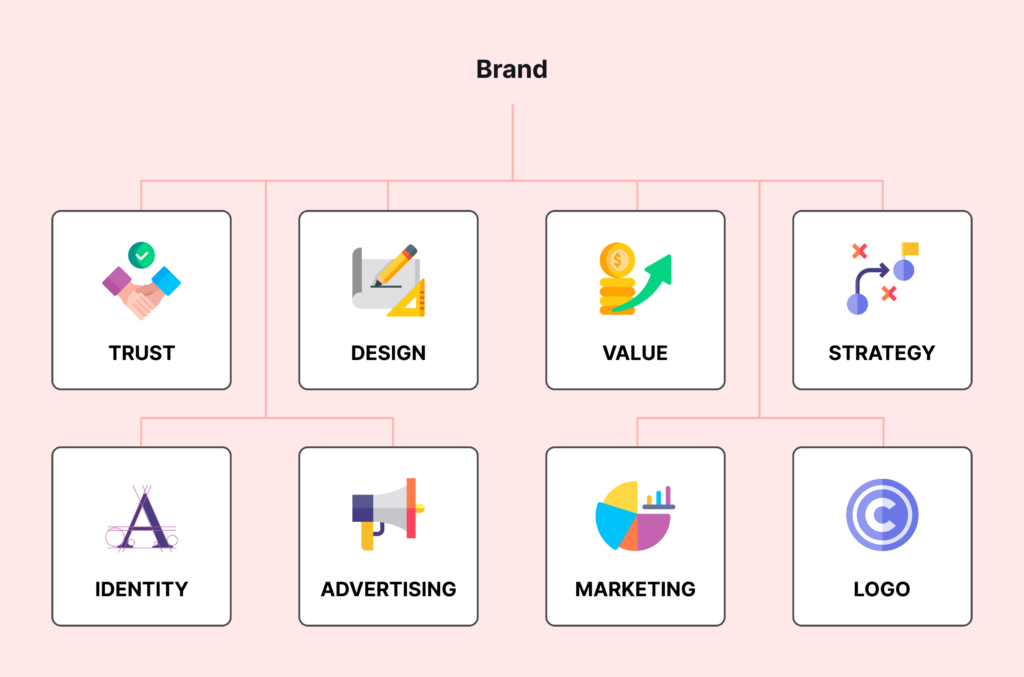
Your own brand should not be an impersonation. Branding does not imply presenting yourself as someone you are not. It is all about consciously and skillfully displaying your true self to your audience and consumers. Your personal brand should be an accurate depiction of your abilities, interests, values, and beliefs. “You want to uncover what makes you unique and focus your brand on that. It can’t be made up; it has to be true, though it may and probably should be overstated,” says Pia Silva. Take stock of your current brand assets. To begin building a solid brand foundation, take inventory of the branding resources you already have.
Your personal brand must be built at the junction of all these assets.
- Your qualifications and capabilities. What abilities have you developed throughout the course of your life? What kind of training, credentials, certificates, or achievements do you have?
- Your hobbies and passions. What businesses and subjects pique your interest? What do you find interesting?
- Core beliefs and values What are some of the most significant basic values in your life? What do you hold dear? What causes do you support? What are you opposed to?
The cornerstone of your personal branding. After you’ve determined your current brand assets, begin stitching together the important parts of your personal brand.
These will assist you in making decisions as you develop your personal brand.
- Your vision. What do you wish to be remembered for? What would you be recognized for if you became the world’s go-to expert on your topic?
- Your mission. Why do you want to develop your unique personal brand? What is your goal? Who do you want to persuade? What do you want to achieve?
- Your message. What is the main point that you wish to highlight? What message do you intend to promote constantly in your content and marketing? What would you say to your followers if you could only give them one piece of advice?
- Your brand’s persona. What are some of your own qualities and features that you may include in your brand creation? Do you want to be viewed as polished and respectable or as eccentric and daring?
Re Perez states that a strong brand begins with a grasp of who you are, what you stand for, your market, and your positioning. What is the perception that you must develop in order to appeal to the target group that you are attempting to reach?
2. Choose a target group
Efforts to appeal to anyone are one of the most common errors made when developing a personal brand. In truth, not everyone is a best fit for you and your business. To attract your ideal customers, you must be ready to repel those with whom you do not want to do business. This entails selecting a specific target demographic and developing a brand that appeals to them.
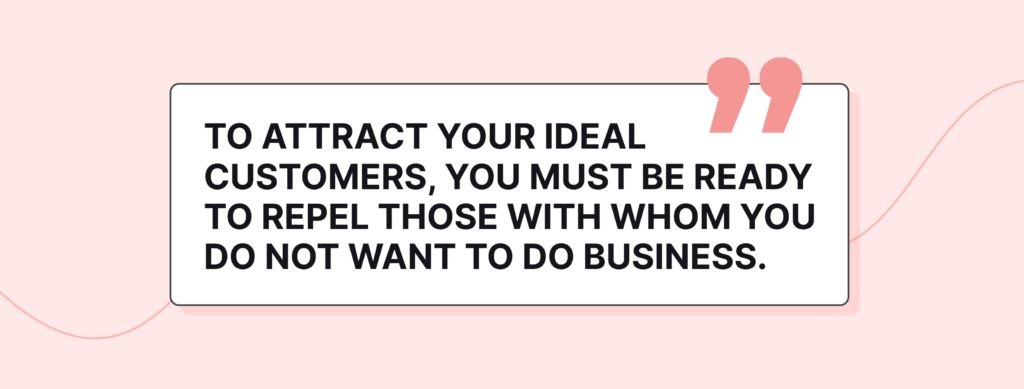
This could sound contradictory, but attempting to be loved by everyone will result in you attracting no one at all. To stand out, you must be divisive. Not everyone who hears or sees your message will like or agree with you, and that is absolutely great. To develop a great business, you don’t have to reach out to everyone. You just need to find your ideal clientele.
Amanda Bond said that you must stand for something, believe in a specific way of doing things, and passionately share those values from your platform to build a strong personal brand. Brands that fail to achieve this receive a tepid audience reaction and wonder why their efforts do not elicit a call to action.
Creating your ideal client profile, often known as a client avatar, is a helpful activity that we encourage. The more you know about your ideal customer, including their needs and difficulties, the more equipped you will be to provide products and services that they actually desire and require.
Here we have prepared some questions to guide you in developing your perfect audience profile.
- Demographics. What are their age, sex, education, relationship status, salary, occupation, and so on?
- Aspirations and desires What is their ideal future? What are their hopes, desires, and goals?
- Problems and difficulties What are they going through? What is keeping them from reaching their objectives?
Kyle Gray is sure that understanding your audience and the difficulties they confront is the cornerstone of a good personal brand. Then you can explain why you care and how you address problems, which is what people will remember you for.
3. Insert an irresistible offer
You must have something to sell to your target audience in order to develop a lucrative personal brand. You need an enticing offer that will assist your audience in solving a specific problem or achieving a certain goal. Many entrepreneurs make the mistake of developing a product or service that they desire only to realize that no one else desires it or is ready to pay for it. This is why it is critical to determine your ideal client before developing a product or service. When you know who you want to assist, you can craft an offer that is the ideal answer for them.
How can you make an offer that your customers will love? The first step in developing an enticing offer is to establish oneself as an expert rather than a generalist. Make a precise guarantee to your clients and create a specialized offer to assist them in accomplishing that promise. A generic offer with a hazy promise is not enticing.
Find the intersection between what you love, what you do best, and what your ideal clients most desire. Then, develop an offer that meets all of these requirements. This is known as the Irresistible Offer Formula.

When you have an enticing offer, you must be able to adequately express it to your consumers. Here are two questions you must be able to answer clearly and concisely.
- What are you going to do? Your unique selling point is the solution to this question. What value do you supply to your customers in return for a fee?
- How do you go about it? Give your procedure, product, or service a distinctive name. When you give it a distinct name, it quickly distinguishes itself from other offerings that promise the same outcome.
For instance, Nicholas Kusmich, who is a Facebook Advertising Strategist, assists businesses in swiftly scaling income by acquiring new clients with Facebook Advertising. That’s exactly what he does. To help him stand out from the millions of other Facebook Advertising gurus doing the same thing, he created a patented technique and named it “Contextual Congruence.” Grant Cardone claims that In the simplest terms possible, people must understand who you are and what you do.” Maintain simplicity. You should be able to describe your brand in 5 words or less.
4. Optimize a personal web page
Your personal web page is a crucial part of developing a personal brand. A very strong social media presence is also crucial, but you do not own or control each of the social networks on which you develop a presence. Your website is a platform that you own and manage, and in many situations, browsing your website is one of the first actions your target audience takes to become a client.
A first impression is really important. When your target audience views your personal website, they should be able to comprehend who you are and how you can assist them right away. They should feel as if they’ve arrived at the appropriate spot. Most new visitors will quit your website if this does not happen within a few seconds.
More significantly, your website should be tailored to turn infrequent visitors into paying customers. There are a few important things needed to make this happen, and the majority of them should be right on your homepage.
Key elements to mention for your website homepage
- A professional logo: hire a designer to create a high-quality logo from your name. If you need a graphic design service, there are a lot of freelancers on the web that would create an appealing logo quickly and at the top level.
- Value proposition: make sure your value proposition and who you help, and how you help them are prominently displayed on your homepage, preferably at the top.
- Professional photography: hire a photographer to shoot you multiple times. Use these images on your website as well as on your social media profiles.
- Social proof, such as media and feedback: include the logos of any newspapers or media sources in which you’ve been featured, as well as client/customer testimonials.
- A precise call-to-action: give your website visitors a clear next step, whether it’s joining your email list, enrolling for a free webinar, or applying for a free consultation.
Other vital sections for a personal branding website In addition to your homepage, your personal brand website should have the following pages.
- Page about me. Tell us about your own experience. How did you get into your field? What qualifications and experience do you have? Who do you assist? How can you assist them? What motivates you to do what you do?
- Services and products. Make it simple for visitors to your website to become clients/customers. List any items, programs, or services that you are selling, along with links to learn more about them or buy them (depending on what your sales process is for each one).
- Free content and resources. Blog entries, podcast series, instructional videos, or resource lists you’ve made or suggested.
- A page for contacting us. Provide a means for your website visitors to contact you. Give them many ways to reach you (email, social media, etc.) depending on why they are contacting you.
Paul Ramondo states that when you create a brand that is completely unique to you, you lay the groundwork for capitalizing on your own blue ocean – a space where you can operate in an uncontested marketplace, free of traditional competitive forces – because none of your competitors can replicate or clone everything that is unique and proprietary to you.
5. Make a content strategy
Effectively, one of the most successful strategies to grow your brand and gain the trust of your target audience is to create and distribute free content. Instead of attempting to persuade your audience that you can assist them, you generate material that truly assists them. This fosters trust and positions you as an expert and authority in your field. Content strategists are frequently well-versed in a variety of methodologies, strategies, and technologies. Content strategists’ viewpoints are also highly influenced by their professional training and education.
Some, for example, specialize in “front-end strategy,” which includes creating personas, journey mapping the user experience, aligning corporate strategy and user requirements, developing a brand strategy, experimenting with various channels, and developing style guidelines and search engine optimization recommendations.
Others focus on “back-end strategy,” which involves developing content models, designing taxonomies and metadata, organizing content management systems, and developing tools to facilitate content reuse. Both jobs entail dealing with workflow and governance challenges.
It’s no accident that the world’s most popular personal brands (Grant Cardone, Marie Forleo, Gary Vaynerchuck, to name only some) produce a lot of content online to help create and maintain their followers.
To begin developing a content plan for your personal brand, make a list of all conceivable themes that would be beneficial to your target group. Google’s Keyword Planner, Answer The Public, and BuzzSumo are surely excellent resources for conducting keyword research and learning about popular subjects. Once you have a list of themes on which to generate content, the following step is to pick what sort of content to develop and where to distribute it.
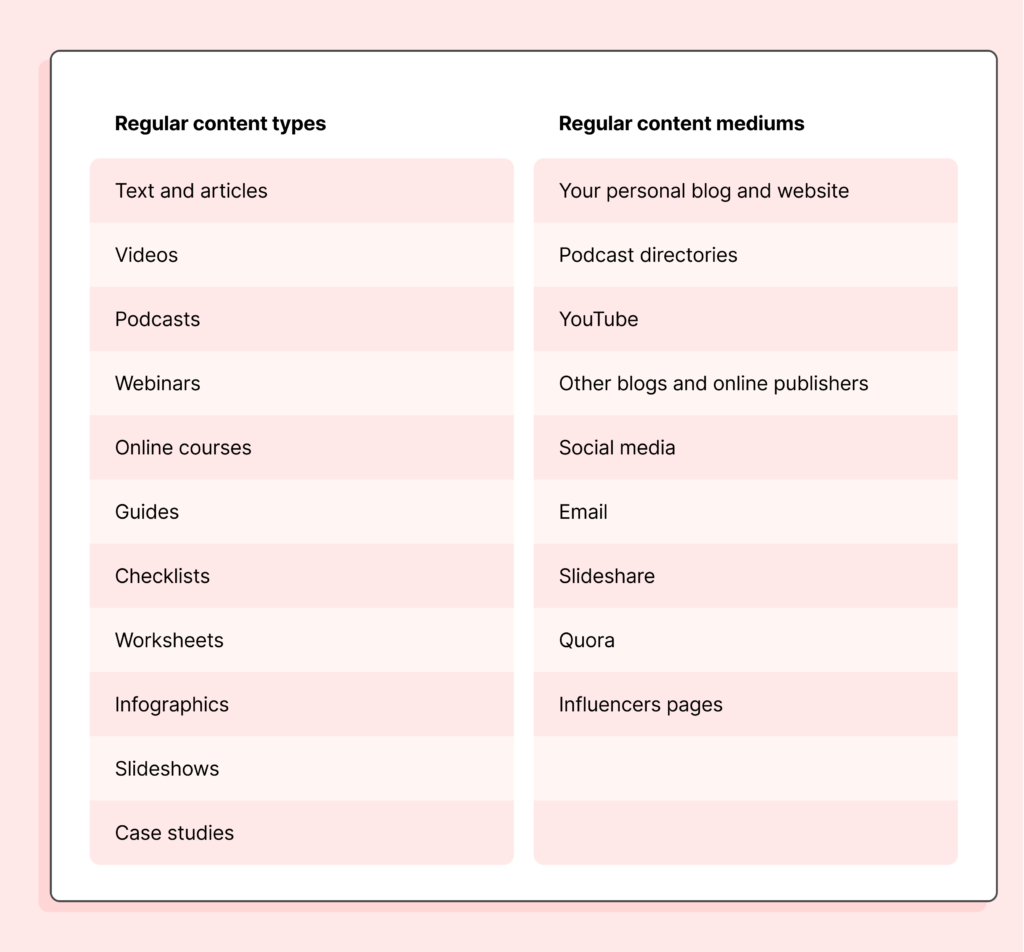
Sam Mallikarjunan recommends clarifying the core themes in which you really believe and creating a series of posts around that and then keep on doing it. Prioritize quality and consistency. To make content marketing work, you must prioritize quality and consistency. Don’t produce content that will reflect adversely on your brand, and be consistent in how frequently you publish fresh information for your followers. Content marketing is a long-term investment that pays off handsomely when done right.
Creating and advertising content takes more time and money than most people believe. As a result, we advise beginning with 1-2 key content kinds, such as blog posts or videos, for example, and 1-2 primary content channels, like YouTube for more info, Youtube Marketing Guide, or Facebook. When you begin to get positive results with your major content kinds and channels, you may begin to extend into additional content types and mediums to reach a wider audience.
Jennifer Gottlieb says that a good personal brand is coherent, clear, and consistent, with the goal of serving a specific audience. A personal brand is essential for an entrepreneur since it is the most effective approach to expressing your real message and attracting your target audience!
6. Create a visibility strategy
Brand visibility is the frequency with which your brand is viewed by your target audience via different marketing channels such as social media, search engines, and others. Business visibility is concerned with recruiting relevant customers to your brand. Publishing content on your personal platforms is an excellent method to grow your following, but it requires a significant amount of work. Exposure to other people’s audiences is a faster method to grow your own.
Here are some basic ways to improve your visibility.
- PR and interviews. Become a guest expert on podcasts, virtual summits, and conventional media such as TV, radio, and print publications
- Blogging as a guest. Articles should be written for other blogs and online media that your target audience reads.
- Speaking in public. Apply to speak at live events, Meetup groups, and conferences attended by your target demographic.
- Joint ventures and partnerships. Building mutually beneficial relationships with other individuals and businesses may lead to a variety of opportunities, such as guest blogging, interviews, joint ventures, collaborations, and consumer recommendations.
Ulyses Osuna mentions that getting oneself mentioned in large newspapers is the single most effective development trick. What better approach to establish authority and credibility in your sector than to have one of the most prominent companies reference you? This provides you with immediate credibility.
7. Build a personal community
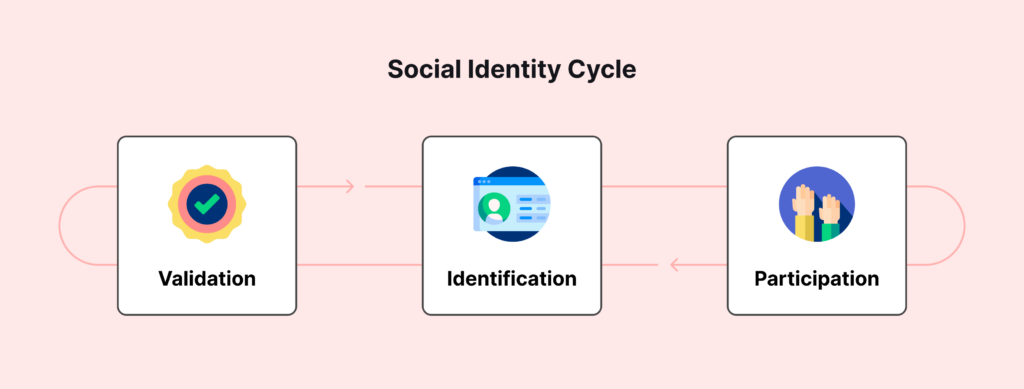
Communities are social groupings that foster fellowship with others by sharing shared interests, objectives, and attitudes. Social media marketers are in charge of creating vibrant communities. It is not enough to have a large social following. You also need an active community.
Instead of attempting to establish a huge and diverse audience, concentrate on being a leader of a community in a certain area. Define your target audience and create a community for people to communicate with one another, share ideas, encourage one another, and contact you directly.
Here we present a few ideas for creating a community around your brand and business.
- Groups on Facebook Make a private Facebook Group for your target demographic or clients. This will allow you to have meaningful dialogues with your audience on a regular basis, as well as provide them with an atmosphere in which they can connect with and support one another.
- Live occurrences. Organize live events so that your audience and/or clients may interact with you in person. Casual get-togethers, private dinners, workshops, retreats, and mastermind groups are all excellent methods to build long-term relationships with your target audience.
- Websites for Members. Create a membership site where, for a small monthly charge, your clients may have access to special information, regular live calls and/or webinars with you, and the
Mark Lack states that a strong personal brand has a high level of effect, which leads to influence among those who follow you.” The idea is to use social media and other social platforms and surroundings to engage in relevant and meaningful discussions with the individuals you wish to influence.
Start building your own personal brand
There has never been a better moment to start a business. The internet and technology have almost eliminated the barriers to entry into entrepreneurship. Anyone may develop a brand and an audience online and then offer items and services to that audience.
You have competition as a freelancer or entrepreneur. However, as a personal brand, you do not. There is no genuine competition when developing a personal brand. Sure, there may be others providing comparable items and services as you, but they are surely not you. In fact, there is no one else on this planet who is precisely like you. You are completely distinct as a person.
This is why developing a personal brand is so effective. When you create a personal brand, you quickly distinguish yourself from your rivals because you are unique. Kathy Klotz-Guest claims, we have a personal brand, whether we realize it or not. So let us be deliberate about it. To me, a strong brand implies that your message is easily recognizable. When you are recognized for something, it reduces the perceived competition. That is enormous!
 Open Sesame: 225 Engaging Email Subject Lines + Crafting Tips
Open Sesame: 225 Engaging Email Subject Lines + Crafting Tips











